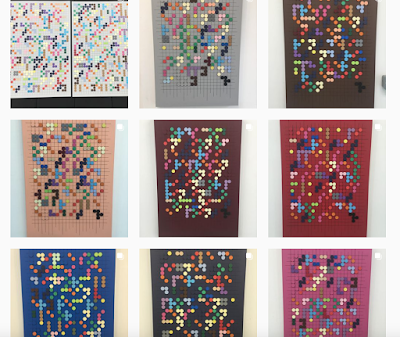Blind painters are difficult to come across and contextualise for my project. As with anything, blindness is a spectrum and there are many different eye conditions. People also experience each condition differently. How one person experiences glaucoma, for example, will be different from how another experiences it. It is extremely individual. I wanted to try and find someone who had experienced retinal detachment and understood how frightening it was but i was not success in my search. What I managed to find were visually impaired artists with a lot more sight than I have.
The language of blindness is often confusing and misused by the media and writers who don't know what the terminology means. Visual impairment/sight impairment, while still part of blindness, is different from being blind and should be encouraged to use more. But it isn't as impactful to say "visually impaired" so people won't used it. We also can't police how people identify themselves. Someone with only one working eye is legally blind and may choose to call themselves as such. You can understand how frustrating this is.
As such, It's difficult to parse who is blind and who is visually impaired. Who is legally blind, with a lot of useful vision, and who is like me and the band of B1 - blind. That's it. The end of the road. The sight isn't coming back. I have around 2% useful vision with a band of light and struggle terribly but want to finish my degree out of stubbornness. I also want a quality of life out of something I enjoy so have forced myself to find something in the artistic field I enjoy. It takes me a long time to do things like artist research but I am here and I am trying. So...
Two blind painters I know of already are:
John Bramblitt - the most prominent "blind" artist and braille.blind.artist (Clarke Reynolds) who I follow on instagram.
I came across this article from Google about 10 "incredible" blind artists. https://www.everydaysight.com/blind-painters/
1. Keith Salmon
Keith studied Fine Art at college and worked as a painter and sculptor after graduation. He is legally blind after diabetic retinopathy. His paintings comprise of abstract landscapes portraying the Scottish highlands that he enjoys exploring. I find his work the most compelling and authentic from the list. His strokes have a sense of movement, a source of light and dark, a softness and abrasiveness, all at the same time. He perfectly captures what it's like to have a blind lens and to struggle to find the detail beyond the darkness. The large dark areas are reminiscent of the dark curtain that pulls across in retinal detachment as the floaters build up.
2. John Bramblitt
The most prominent "blind" artist who I have a huge problem with because of the amount of gallery work he has been offered. His portfolio says nothing of what it is like to be a blind person when he has the platform to do that. He also states he can parse which paint is which because of its thickness, which is damaging to the blind community as we are not superheroes. We absolutely have ways of doing things but thickness of paint is not one of them. Whether this was misquoted in a news article, I do not know. As someone who uses paints, this throws me. What DOES exist is apps that can detect colour with great accuracy as well as the Be My Eyes app where a sighted volunteer is partnered at random to a blind or visually impaired user and can help them with their request.
I have finally come across an article that refers to him as visually impaired, because I do feel that is what he is. As I was before my retinal detachment. Again, it is finding the importance and differentiating that terminology and using it correctly. His work is perfectly representational, on large scales including murals. He draws perfect people and animals - something I no longer have the ability to do and had to give up my dream of illustrating. I had to literally force myself to do the stamp project, with great difficulty to complete the brief, and I'm glad I never have to do it again. He has great use of colour.
Arthur Ellis is the artist who 'lost his sight but not his vision.' He became legally blind after bacterial meningitis. His artwork showcases loose, abstract line work that "focuses on the merging of colours and shapes." This piece in particular has many illustrative qualities and much like blind contour drawing which I did myself in my monoprint series where I traced my face into my monoprint. It has an immediacy, movement and compositional interest.
Not on the list but who I follow on Instagram
@blind.braille.artist:
Clarke Reynolds is registered severely sight-impaired and works with braille to educate others at exhibitions and schools. He paints canvas dots using Valspar paint, purchased at B&Q, and arranges them onto a board that he scores and aligns into a graph formation so they read correctly. He sells his pieces to raise money for sight loss charities. I like Clarke's approach to making work. He doesn't come from any artistic background but enjoys being creative. He uses the resources he has available to him, from hardware stores, to make work in his practice. His conducts his own workshops for companies and schools to engage with Braille and the experience of being a visually impaired person during the pandemic. His colourful pieces are impactful and open a line of communication with the sighted audience. His work is relevant to mine as I utilised braille earlier in my project, in a "letters in braille" monoprint series, to portray the language in a different kind of way. My pieces were lo-fi, grungy and oftentimes looked deconstructed.






No comments:
Post a Comment